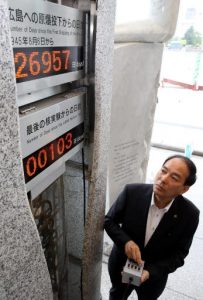A-bombed city stages protests against U.S. subcritical nuclear test
May 28, 2019
by Junji Akechi, Michiko Tanaka, and Yuichi Yamazaki, Staff Writers
On May 27, in response to the recently learned news that the United States had conducted a subcritical nuclear test in February, which did not produce a nuclear explosion, citizens in the A-bombed city of Hiroshima staged protests against the Trump administration, including sit-ins and letters of protest from local governments. At the Peace Memorial Museum in Naka Ward, the clock of the Peace Watch Tower was reset. This clock indicates the number of days since the world’s last nuclear test was carried out.
A sit-in was staged by the Hiroshima Peace Liaison Conference for Nuclear Abolition, an association of 12 groups including the Hiroshima Prefectural Confederation of A-bomb Sufferers Organization (Hiroshima Prefectural Hidankyo, chaired by Sunao Tsuboi) and the Hiroshima Local of Japanese Trade Union Confederation, in front of the Cenotaph for the A-bomb Victims in the Peace Memorial Park. A total of 78 people took part in the sit-in, holding a long banner that read “We strongly protest against all nuclear tests.” Toshiyuki Mimaki, 77, the acting chair of the Hiroshima Prefectural Hidankyo, said, “I’m very disappointed at this news, because the A-bomb survivors have been working so hard to abolish nuclear weapons. I would like other citizens of Hiroshima to express their outrage, too.” On the same day, in front of the Fuchu City Hall, the Hiroshima Congress against A-and-H Bombs (Hiroshima Gensuikin) in Fuchu staged another sit-in. Fourteen people, including city council members and city officials, took part in the protest.
This was the first time that a nuclear test performed by the United States has been disclosed since that nation’s subcritical nuclear test, performed in December 2017, was revealed in October 2018. On the first floor of the museum’s east building, the number display on the clock, which had shown “530,” was changed to “103,” the number of days since February 13 of this year, the day the United States conducted the latest nuclear test. Takuo Takigawa, the director of the museum, said, “We would like to make further efforts to convey the real conditions of the atomic bombing more widely and accurately so this nuclear test will be the last one.”
In a letter of protest addressed to U.S. President Donald Trump, Hiroshima Mayor Kazumi Matsui called on Mr. Trump to stop conducting nuclear tests, writing “Your country’s actions ignore the wish of the hibakusha and millions of others who seek the abolition of nuclear weapons and are utterly unacceptable.” The mayors of other cities in Hiroshima Prefecture, including Takehara, Onomichi, Fukuyama, Fuchu, Miyoshi, Shobara, Higashihiroshima, Hatsukaichi, and Akitakata, sent letters of protest to the U.S. president, too. Masakazu Yasui, the secretary general of The Japan Council against Atomic and Hydrogen Bombs (Gensuikyo), also released a statement in protest which said “Subcritical nuclear tests for maintaining and strengthening your nuclear arsenal will fuel a nuclear arms race.”
(Originally published on May 28, 2019)
On May 27, in response to the recently learned news that the United States had conducted a subcritical nuclear test in February, which did not produce a nuclear explosion, citizens in the A-bombed city of Hiroshima staged protests against the Trump administration, including sit-ins and letters of protest from local governments. At the Peace Memorial Museum in Naka Ward, the clock of the Peace Watch Tower was reset. This clock indicates the number of days since the world’s last nuclear test was carried out.
A sit-in was staged by the Hiroshima Peace Liaison Conference for Nuclear Abolition, an association of 12 groups including the Hiroshima Prefectural Confederation of A-bomb Sufferers Organization (Hiroshima Prefectural Hidankyo, chaired by Sunao Tsuboi) and the Hiroshima Local of Japanese Trade Union Confederation, in front of the Cenotaph for the A-bomb Victims in the Peace Memorial Park. A total of 78 people took part in the sit-in, holding a long banner that read “We strongly protest against all nuclear tests.” Toshiyuki Mimaki, 77, the acting chair of the Hiroshima Prefectural Hidankyo, said, “I’m very disappointed at this news, because the A-bomb survivors have been working so hard to abolish nuclear weapons. I would like other citizens of Hiroshima to express their outrage, too.” On the same day, in front of the Fuchu City Hall, the Hiroshima Congress against A-and-H Bombs (Hiroshima Gensuikin) in Fuchu staged another sit-in. Fourteen people, including city council members and city officials, took part in the protest.
This was the first time that a nuclear test performed by the United States has been disclosed since that nation’s subcritical nuclear test, performed in December 2017, was revealed in October 2018. On the first floor of the museum’s east building, the number display on the clock, which had shown “530,” was changed to “103,” the number of days since February 13 of this year, the day the United States conducted the latest nuclear test. Takuo Takigawa, the director of the museum, said, “We would like to make further efforts to convey the real conditions of the atomic bombing more widely and accurately so this nuclear test will be the last one.”
In a letter of protest addressed to U.S. President Donald Trump, Hiroshima Mayor Kazumi Matsui called on Mr. Trump to stop conducting nuclear tests, writing “Your country’s actions ignore the wish of the hibakusha and millions of others who seek the abolition of nuclear weapons and are utterly unacceptable.” The mayors of other cities in Hiroshima Prefecture, including Takehara, Onomichi, Fukuyama, Fuchu, Miyoshi, Shobara, Higashihiroshima, Hatsukaichi, and Akitakata, sent letters of protest to the U.S. president, too. Masakazu Yasui, the secretary general of The Japan Council against Atomic and Hydrogen Bombs (Gensuikyo), also released a statement in protest which said “Subcritical nuclear tests for maintaining and strengthening your nuclear arsenal will fuel a nuclear arms race.”
(Originally published on May 28, 2019)








